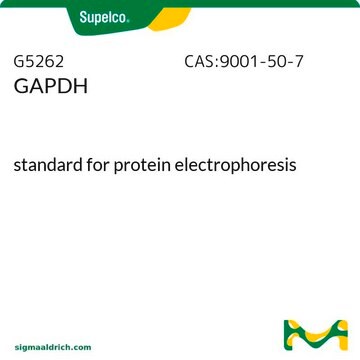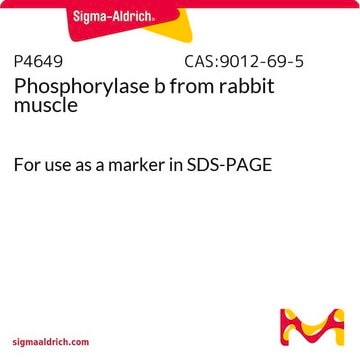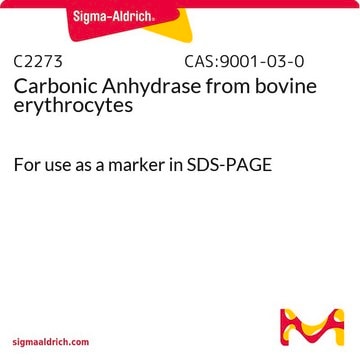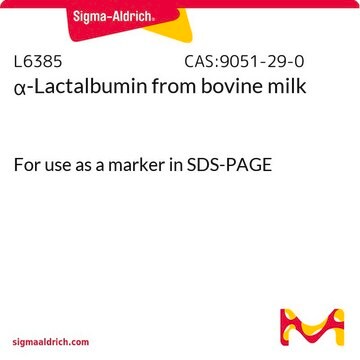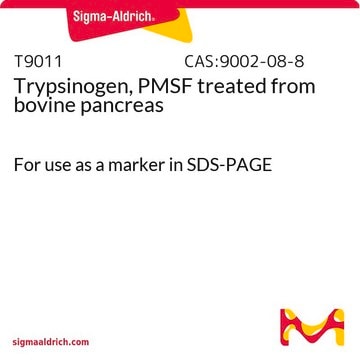Soybean trypsin inhibitor is a mixture of the three types. We have not characterized our trypsin inhibitor products in terms of how much of each of the three types may be present. All three have a molecular weight of between 20,000 and 20,200 daltons, so one might use 20,100 daltons as an average.The three types vary in the amino acids at a few positions. The detailed summary of the three types (or variants) was published in the following linked reference: J. Biochem. (Japan), 98, 435-448 (1985).Note that the authors use Tia, Tib and Tic to indicate the three variants.
T9767
Trypsin inhibitor
powder, suitable for electrophoresis
Sinónimos:
SBTI
Seleccione un Tamaño
214,00 €
Seleccione un Tamaño
About This Item
214,00 €
Productos recomendados
Nombre del producto
Trypsin inhibitor from Glycine max (soybean), For use as a marker in SDS-PAGE, BioReagent
origen biológico
Glycine max (soybean)
Nivel de calidad
Línea del producto
BioReagent
Formulario
powder
mol peso
20,000 Da
envase
vial of 5 mg
técnicas
electrophoresis: suitable
solubilidad
balanced salt solution: 1 mg/mL
concentrate: >10 mg/mL, hazy, amber-yellow
phosphate buffer: 10 mg/mL
water: 10 mg/mL
serum-free medium: soluble
Condiciones de envío
ambient
temp. de almacenamiento
2-8°C
¿Está buscando productos similares? Visita Guía de comparación de productos
Aplicación
Acciones bioquímicas o fisiológicas
Componentes
Definición de unidad
Nota de preparación
Solutions can retain activity when stored short-term at 2-8° C. Solutions are stable in frozen aliquots at -20°C.
Aplicación
Producto relacionado
Palabra de señalización
Danger
Frases de peligro
Consejos de prudencia
Clasificaciones de peligro
Resp. Sens. 1 - Skin Sens. 1
Código de clase de almacenamiento
11 - Combustible Solids
Clase de riesgo para el agua (WGK)
WGK 3
Punto de inflamabilidad (°F)
Not applicable
Punto de inflamabilidad (°C)
Not applicable
Equipo de protección personal
Eyeshields, Gloves, type N95 (US)
Elija entre una de las versiones más recientes:
Certificados de análisis (COA)
¿No ve la versión correcta?
Si necesita una versión concreta, puede buscar un certificado específico por el número de lote.
¿Ya tiene este producto?
Encuentre la documentación para los productos que ha comprado recientemente en la Biblioteca de documentos.
Los clientes también vieron
Artículos
For use as a marker in SDS-PAGE; Albumin from chicken egg white, For use as a marker in SDS-PAGE; L-Lactic Dehydrogenase from rabbit muscle, Type XI, lyophilized powder, 600-1,200 units/mg protein
Protocolos
Natural trypsin inhibitors (serpins) regulate protein activation and catabolism by inhibiting serine proteases in vivo.
Chromatograms
application for HPLC-
What is the molecular weight and amino acid sequence of trypsin inhibitor from Glycine max (soybean)?
1 respuesta-
¿Le ha resultado útil?
-
Filtros activos
Nuestro equipo de científicos tiene experiencia en todas las áreas de investigación: Ciencias de la vida, Ciencia de los materiales, Síntesis química, Cromatografía, Analítica y muchas otras.
Póngase en contacto con el Servicio técnico


